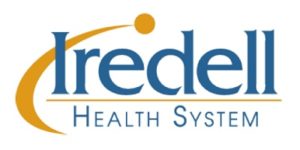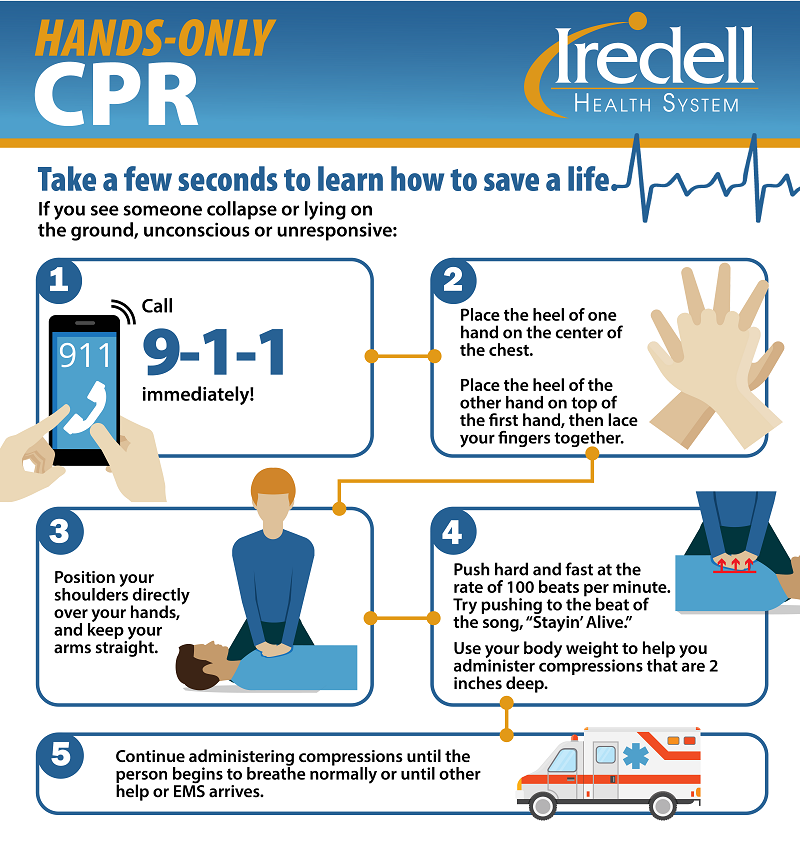
Special to Iredell Free News
Imagine you are at a baseball game and see someone collapse in the stands. People yell, “Who knows CPR?” but everyone looks at one another, and there is no medical professional at the game.
Unfortunately, this type of scenario happens all too often.
The good news? You can step up to the plate and save a life.
Cardiac arrest—when the heart stops functioning properly—can happen anywhere. According to the American Heart Association (AHA), more than 350,000 cardiac arrests occur outside of the hospital each year. Unless it’s treated quickly, cardiac arrest is often fatal.
Cardiopulmonary resuscitation (CPR), if begun immediately, can double or triple the chances of survival.
“Every minute CPR is delayed, the victim’s chance of survival decreases by 10 percent,” said Diane Galati, stroke and chest pain coordinator at Iredell Health System.
However, a new AHA survey revealed that four out of every ten people said they would not initiate CPR.
If CPR is life-saving, then why are so many bystanders hesitant to help?
Galati believes one reason may be that bystanders are worried about giving resuscitation breaths. Other reasons may be lack of training or fear of hurting the victim.
Luckily, Hands-Only CPR is a relatively simple technique that any bystander can learn to do, even without formal training or a medical background.
What is Hands-Only CPR?
If you do not know how to do conventional CPR with breaths, you can still help in an emergency with Hands-Only CPR.
As the name suggests, Hands-Only CPR involves using your hands for chest compressions without performing resuscitation breaths, or “mouth-to-mouth.”
“You do not need any formal training to perform Hands-Only CPR. If you know the steps, anybody can perform life-saving Hands-Only CPR,” said Galati.
Hands-only CPR has been shown to be as effective in the first few minutes as conventional CPR with breaths for cardiac arrest.
Who should receive Hands-Only CPR?
Hands-Only CPR is recommended for use on teens or adults who suddenly collapse from cardiac arrest. If you witness a teen or adult suddenly collapse and they are unresponsive, you can assume cardiac arrest is likely the cause.
The AHA still recommends conventional CPR with breaths for infants, children, victims of drowning or drug overdose, or people who collapse due to breathing problems.
Do I have to check their breathing or pulse?
With Hands-Only CPR, the AHA states you do not need to check the breathing or pulse of the victim before beginning chest compressions. If you are not a healthcare professional, checking the victim’s breathing or pulse will only delay the start of vital chest compressions.
How does Hands-Only CPR work?
According to the AHA, when a teen or adult suddenly collapses from cardiac arrest, they usually have enough oxygen to keep vital organs healthy for the first few minutes. Providing chest compressions that are hard and fast enough will help pump blood to the heart and brain. That’s why immediately starting compressions is key.
Can CPR hurt the victim?
The chance of injury is minimal compared to the opportunity to save a life. In this case, it’s better to be safe and try than to be sorry and lose a life.
Galati states that you may hear ribs crack when you are doing Hands-Only CPR, but to continue with the chest compressions.
“You may hear ribs crack, but do not be afraid because it is normal,” said Galati.
A sore chest or a broken rib is much better than the alternative. Any attempt to provide CPR to a victim is better than no attempt to provide help.

Performing Hands-Only CPR
If you see a teen or adult collapse, you can perform Hands-Only CPR in just a few steps. According to Galati, you should:
1. Call 911 immediately.
2. Ensure the person is on a firm, flat surface.
3. Place the heel of one hand on the center of the chest. Place the heel of the other hand on top of the first hand, then lace your fingers together.
4. Position your shoulders directly over your hands, and keep your arms straight.
5. Push hard and fast at the rate of 100-120 beats per minute. Try pushing to the beat of the song, “Stayin’ Alive.” Use your body weight to help you administer compressions that are two inches deep.
6. Continue administering compressions until the person begins breathing and has a pulse, or until professional medical help arrives. They will likely provide some level of response, such as moaning, opening of the eyes, or body movements.
Not familiar with “Stayin Alive?” Don’t worry! There are several songs that can help you stay on that 100-120 beats per minute rhythm:
♦ For country music fans – Jolene by Dolly Parton
♦ For parents of young children – Baby Shark
♦ For “Swifties” – The Man by Taylor Swift
LEARN MORE
To learn more, or to see an instructional video about Hands-Only CPR, you can visit the American Heart Association’s website at cpr.heart.org/en/cpr-courses-and-kits/hands-only-cpr.
About Iredell Health System
Iredell Health System includes Iredell Memorial Hospital; Iredell Mooresville; Iredell Home Health; Iredell Wound Care & Hyperbaric Center; Community and Corporate Wellness; Occupational Medicine; the Iredell Physician Network and more. Iredell Memorial Hospital is the largest and only nonprofit hospital in Iredell County. The comprehensive healthcare facility has 247 beds; more than 1,800 employees; and has 260 physicians representing various specialties. Centers of excellence include Women’s and Children’s; Cardiovascular; Cancer; Surgical Services and Wellness & Prevention. The Health System’s newest campus, Iredell Mooresville, is home to the area’s only 24-hour urgent care facility, as well as an ambulatory surgery center, imaging center, rehabilitation services, and physician practices. The mission of Iredell Health System is to inspire wellbeing. For a comprehensive list of services and programs, visit www.iredellhealth.org



